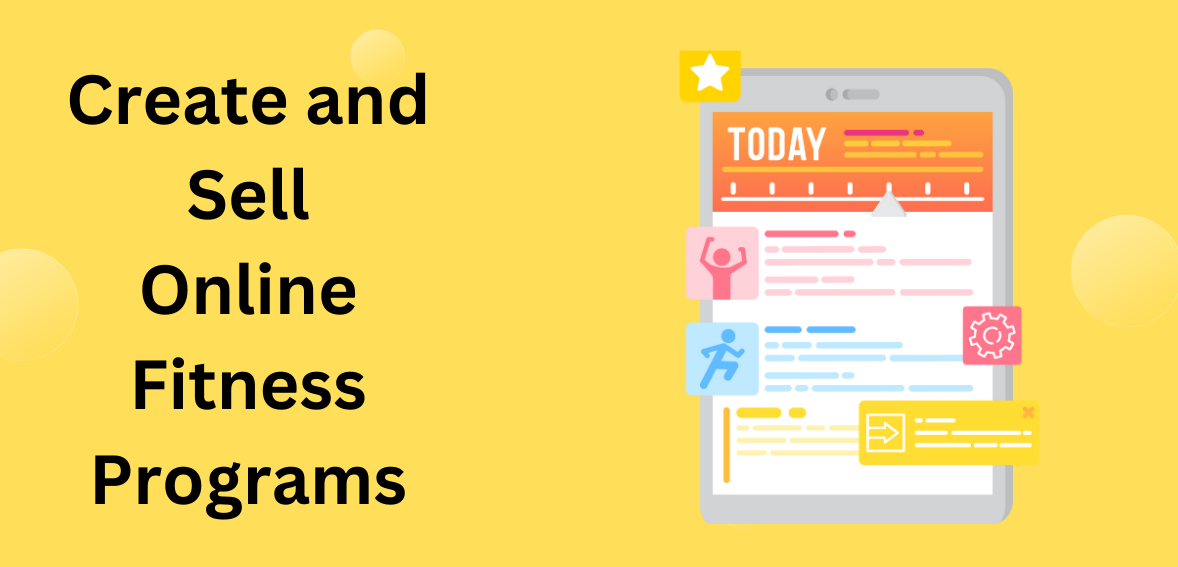Welcome to the world of online fitness programs, where you have the power to transform lives from the comfort of your own home! In today’s digital age, more and more people are turning to virtual workouts as a convenient and effective way to achieve their health and fitness goals. Whether you’re a certified personal trainer or a passionate fitness enthusiast looking to share your knowledge, creating and selling online fitness programs can be an incredibly rewarding venture.
But how do you create a program that not only meets the needs of your clients but also leaves them coming back for more? That’s where we come in! In this blog post, we’ll guide you through each step of the process, from understanding the demand for online fitness programs all the way to measuring success and making adjustments along the way. So grab your water bottle and let’s dive into this exciting journey together!
Understanding the demand for online fitness programs
In today’s fast-paced world, where time is a precious commodity and convenience is key, it’s no surprise that the demand for online fitness programs has skyrocketed. People are seeking flexible workout options that fit seamlessly into their busy schedules, without compromising on quality or results.
One of the main reasons behind this surge in popularity is accessibility. With just a few clicks, individuals can access an array of fitness programs tailored to their specific needs and goals. Whether they’re looking to lose weight, build muscle, improve flexibility, or simply maintain overall health and well-being, there’s an online program out there for everyone.
Another factor contributing to the demand for virtual workouts is cost-effectiveness. Traditional gym memberships can be expensive and often require additional expenses such as transportation and childcare. Online fitness programs offer a more affordable alternative without sacrificing the expertise of qualified trainers.
Moreover, technology has played a significant role in driving the demand for online fitness programs. With advancements in streaming services and video platforms, individuals can now enjoy high-quality workout sessions from the comfort of their own homes. They have the freedom to choose when and where they want to exercise – whether it’s early morning before work or late at night after putting the kids to bed.
Furthermore, with social media influencers promoting health-conscious lifestyles and showcasing impressive transformations achieved through online fitness programs – word-of-mouth marketing has taken on new heights! Social proof plays a crucial role in convincing potential clients about program effectiveness.
As we move forward into an increasingly digital era, understanding these factors will help you tap into the ever-growing market of individuals who crave convenient yet effective ways to stay fit. By recognizing and adapting to this demand for online fitness programs, you’ll be well-positioned to create offerings that attract loyal clients eager for guidance on their wellness journey.
Choosing a niche and target audience
Choosing a niche and target audience is a crucial step in creating and selling online fitness programs that clients love. By narrowing down your focus, you can tailor your program to meet the specific needs and interests of your chosen audience.
One way to determine your niche is by considering your own passions and expertise. Are you particularly knowledgeable about strength training, yoga, or weight loss? By honing in on what you excel at, you can position yourself as an expert in that area.
Next, think about who would benefit most from your program. Is it busy moms looking for quick workouts they can do at home? Or perhaps it’s athletes seeking specialized training routines. Understanding who your ideal client is will allow you to create content that resonates with them.
Researching the market can also help identify gaps or untapped opportunities within the fitness industry. Look for trends or emerging topics that have high demand but limited competition. This could be anything from postnatal fitness to virtual personal training.
Consider the demographics of your target audience. Age range, gender, location – all these factors play a role in crafting targeted marketing messages and tailoring program features to suit their preferences.
By carefully choosing a niche and target audience for your online fitness program, you set yourself up for success by delivering exactly what clients are looking for!
Creating a captivating program name and brand
When it comes to creating a captivating program name and brand for your online fitness program, you want to make sure that it stands out from the crowd. The name should be catchy and memorable, while also conveying the essence of what your program is all about.
Start by brainstorming different words and phrases that relate to fitness, health, and wellness. Think about what sets your program apart from others in the market – whether it’s a unique training approach or a specific target audience.
Once you have some ideas, narrow down your options by considering how each name aligns with your overall brand image. Is it aligned with your values and mission? Does it resonate with your target audience?
Next, think about how you can visually represent your brand through design elements such as logo, color scheme, and typography. These visual elements will help create a cohesive brand identity that attracts potential clients.
Remember to keep things simple yet impactful. A cluttered or confusing brand name may turn potential customers away. Aim for something that is easy to pronounce and remember.
Don’t be afraid to test out different names on focus groups or gather feedback from trusted friends or colleagues before finalizing one for your program.
Designing effective and engaging workouts
Designing effective and engaging workouts is crucial when it comes to creating online fitness programs that clients love. To keep your participants motivated and coming back for more, you need to create workouts that are both challenging and enjoyable.
One key aspect of designing effective workouts is variety. This means incorporating a mix of different exercises, targeting different muscle groups, and varying the intensity levels. By offering a diverse range of exercises, you can prevent boredom and ensure that your clients are constantly challenged.
Another important factor is progression. Gradually increasing the difficulty level of the workouts will help your clients see consistent progress in their fitness journey. Whether it’s through increasing weights or adding more repetitions, progression not only keeps things interesting but also helps individuals reach their fitness goals faster.
Additionally, incorporating interactive elements into your workouts can enhance engagement. Consider using video demonstrations or live streaming sessions where participants can follow along in real-time. Encouraging interaction through virtual challenges or competitions can also boost motivation and foster a sense of community among participants.
Don’t forget to include modifications for all fitness levels. Not everyone starting your program will be at the same level of fitness, so providing options for beginners as well as advanced athletes ensures inclusivity and allows each participant to work at their own pace.
By focusing on variety, progression, interactivity, and inclusivity in your workout design process, you can create an online fitness program that will captivate and inspire your clients every step of the way!
Incorporating nutrition and meal planning into your program
Incorporating nutrition and meal planning into your program is essential for creating a comprehensive and effective online fitness experience. By providing your clients with guidance on healthy eating habits, you can help them achieve their fitness goals more efficiently.
Start by educating yourself on the basics of nutrition and understanding how different foods impact the body. This knowledge will enable you to design meal plans that are tailored to your client’s specific needs and preferences.
When creating meal plans, consider factors such as calorie intake, macronutrient balance, and portion sizes. Strive to provide a variety of nutritious options that are both delicious and satisfying for your clients.
To make it easier for your clients to follow the meal plans, consider offering grocery lists or even pre-made recipes. This will save them time and ensure they have all the necessary ingredients readily available.
It’s also important to emphasize the importance of consistency in following the meal plans. Encourage your clients to track their food intake and provide support when they face challenges or slip-ups.
Remember that every person’s nutritional needs are unique, so be open to adjusting and personalizing the meal plans based on individual feedback from your clients. Regularly check in with them about their progress and ask for input on what is working well or could be improved upon.
By incorporating nutrition into your online fitness program, you’ll not only enhance its effectiveness but also show that you care about supporting overall health and wellness. So don’t overlook this crucial aspect – it can truly make a difference in helping your clients reach their fitness goals!
Utilizing social media and marketing strategies to promote your program
Utilizing social media and marketing strategies is crucial for promoting your online fitness program and reaching a wider audience. With the right tactics, you can effectively engage with potential clients and generate interest in your program.
Identify which social media platforms are most popular among your target audience. Whether it’s Instagram, Facebook, or YouTube, each platform offers unique opportunities to showcase your program. Create engaging content such as workout videos, healthy recipe ideas, and motivational posts to capture the attention of your followers.
Take advantage of hashtags related to fitness and wellness trends to expand your reach beyond just your immediate followers. This will increase the chances of attracting new clients who are searching for relevant content.
Collaborate with influencers or other professionals in the fitness industry who align with your brand values. By partnering with them for sponsored posts or guest appearances on their channels, you can tap into their existing audience and gain credibility.
Consider running targeted ads on social media platforms to further boost visibility. Utilize demographic targeting options available on these platforms to ensure that your ads are seen by individuals within specific age groups or geographical locations.
Engage with your audience by responding promptly to comments and messages. Show genuine interest in their progress and provide helpful tips or advice whenever possible.
Consider hosting live Q&A sessions or webinars where potential clients can interact directly with you. This allows them to get a sense of what they can expect from joining your program while also building trust in you as an expert.
Remember that consistency is key when it comes to utilizing social media for marketing purposes. Stay active on these platforms by regularly posting valuable content that resonates with both current clients and potential leads.
Providing exceptional customer service and support
Providing exceptional customer service and support is crucial when it comes to creating and selling online fitness programs that clients love. When your clients feel valued and supported, they are more likely to stick with the program and achieve their fitness goals.
One way to provide outstanding customer service is by being responsive and accessible. Respond promptly to any inquiries or concerns from your clients, whether it’s through email, social media, or a dedicated support system. Make sure you have clear communication channels in place so that your clients can easily reach out for assistance.
Another important aspect of exceptional customer service is personalization. Take the time to get to know your clients individually and understand their unique needs and goals. This will allow you to tailor your program recommendations and advice specifically for them.
Additionally, providing ongoing motivation and encouragement is key. Keep in touch with your clients regularly through newsletters or motivational messages on social media platforms. Celebrate their successes along the way, no matter how small they may seem.
Don’t forget about post-program support. Offer resources or continued guidance after the completion of the program so that your clients can maintain their progress long-term.
By prioritizing exceptional customer service throughout every step of the journey, you’ll create a loyal client base who not only loves your program but also becomes an advocate for it among friends and family!
Measuring success and making adjustments to improve the program
Measuring the success of your online fitness program is crucial to its long-term growth and effectiveness. By analyzing key metrics, you can identify areas for improvement and make necessary adjustments to ensure your clients are getting the best experience possible.
One important metric to track is client engagement. Are participants completing their workouts consistently? Are they actively participating in any challenges or community discussions? Monitoring engagement levels will provide insights into how well your program resonates with your target audience.
Tracking client progress is another essential aspect of measuring success. Are participants achieving their fitness goals? Are they seeing improvements in strength, endurance, or body composition? By collecting data on individual progress, you can gauge the overall effectiveness of your program and make adjustments as needed.
Feedback from clients is invaluable when it comes to improving your program. Encourage open communication and listen carefully to their suggestions and concerns. This feedback can help you identify areas where modifications may be necessary or uncover new ideas for enhancing the user experience.
Regularly reviewing sales data will also give you insights into the popularity and profitability of different aspects of your program. Are certain workout routines more popular than others? Is there a demand for additional services such as personalized meal plans or coaching sessions?
In addition to quantitative metrics, qualitative feedback should also be considered when evaluating program success. Conduct surveys or interviews with clients to gather detailed feedback about what they liked most about the program and what could be improved upon.
Remember that no online fitness program is perfect from day one. It’s an ongoing process of learning, adapting, and fine-tuning based on real-time data and client feedback. By continuously measuring success and making necessary adjustments along the way, you’ll ensure that your online fitness program evolves into something truly exceptional that clients love!
Tips for selling your program at different price points
1. Understand Your Target Audience: Before setting your prices, it’s crucial to understand the needs and budgets of your target audience. Conduct market research or surveys to gain insights into what they are willing to pay for an online fitness program.
2. Offer Multiple Options: To cater to a diverse range of customers, consider offering different price points for your program. For example, you could have a basic package with essential features at a lower price and a premium package with additional benefits at a higher price.
3. Bundle Additional Services: Increase the perceived value of your program by including bonus features or services that complement the workouts and nutrition plans. This can be personalized coaching sessions, access to exclusive content, or even discounts on fitness equipment.
4. Provide Flexible Payment Plans: Some clients may prefer paying in installments rather than upfront fees. Offering flexible payment options like monthly subscriptions or quarterly payments can make your program more accessible and appealing.
5. Demonstrate Value through Testimonials and Success Stories: Highlighting success stories from happy clients who have achieved their fitness goals using your program can provide social proof and reassure potential buyers about the value they will receive.
6. Utilize Limited-Time Offers and Discounts: Creating urgency with limited-time offers or special discounts can incentivize potential customers to take action quickly before missing out on the deal.
Remember, pricing strategies should align with both the quality of your program and what customers perceive as fair value for their investment in achieving their fitness goals!
Conclusion:
Creating and selling online fitness programs can be a rewarding endeavor that allows you to share your passion for health and wellness with clients around the world. By understanding the demand for online fitness programs, choosing a niche and target audience, creating a captivating program name and brand, designing effective workouts, incorporating nutrition planning, utilizing social media marketing strategies, providing exceptional customer service and support, measuring success, making adjustments to improve the program, and considering different price points for selling your program – you can set yourself up for success.
Remember to always stay engaged with your clients throughout their fitness journey. Continuously seek feedback from them in order to make improvements to your program. Keep an eye on industry trends and adapt accordingly.
With dedication and persistence, you can create online fitness programs that not only meet the needs of your target audience but also exceed their expectations. So go ahead, put these tips into action today and start building an online fitness empire that clients will love!
Now is the perfect time to tap into the growing market of virtual workouts. Embrace technology as a tool to reach more people than ever before – all while helping them achieve their fitness goals from the comfort of their own homes. Get started on creating an online fitness program today!



























